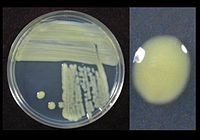
Photo from wikipedia
Citrus canker (CC), caused by the bacterial pathogen Xanthomonas citri subsp. citri (Xcc), impacts citrus production in many areas of the world by reducing yields, degrading tree health, and severely… Click to show full abstract
Citrus canker (CC), caused by the bacterial pathogen Xanthomonas citri subsp. citri (Xcc), impacts citrus production in many areas of the world by reducing yields, degrading tree health, and severely blemishing the outer peels of fresh fruit. The relative susceptibility to CC among different species of Citrus varies from the highly susceptible lime (Citrus x aurantifolia), sweet orange (C. x sinensis), and grapefruit (C. x paradisi) to the much less susceptible calamondin (C. x microcarpa) and kumquat (C. japonica). This investigation compares the responses to infection with Xcc of these five genotypes with respect to phenylpropanoid compound profiles and relative increases or decreases of specific compounds post inoculation. In response to Xcc infection, all hosts possessed increased concentrations of phenylpropanoids in leaf tissue, while the similarly treated non-host orange jessamine (Murraya paniculata) did not. Several of the tested genotypes exhibited notably increased production of fluorescent phenylpropanoids, including umbelliferone, herniarin, auraptene, scoparone, and others. The profiles of these compounds and their levels of production varied among the tested species, yet all investigated Citrus genotypes exhibited increased concentrations of phenylpropanoids irrespective of their degree of susceptibility to Xcc. Kumquat and calamondin, the tested genotypes least susceptible to Xcc, also exhibited the highest levels of the dihydrochalcone, 3',5'-di-C-glucosyl phloretin, the aglycone portion of which, phloretin, is a known antibiotic, although levels of this compound were not affected by inoculation with Xcc.
Journal Title: Phytopathology
Year Published: 2019
Link to full text (if available)
Share on Social Media: Sign Up to like & get
recommendations!